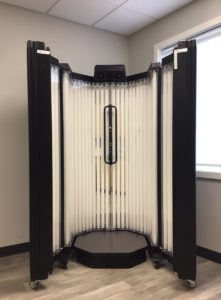What is Phototherapy?
Phototherapy, also known as light therapy, is a treatment that uses various wavelengths of natural ultraviolet (UV) light. It is prescribed to treat various skin conditions such as psoriasis, eczema, prurigo nodularis, pruritus (skin itching), vitiligo, and mycosis fungoides. At Advanced Dermatology & Skin Surgery, we offer the most common type of phototherapy which is narrowband ultraviolet (NB-UVB) light. Narrow Band UVB virtually eliminates extra and harmful UV by emitting only wavelengths 311-312nm. Clinical studies show the peak therapeutic effectiveness of UVB to be within the range of 295-313nm, however wavelengths below 300 nm can cause erythema or severe burning and increase the risk of skin cancer without significant improvement to reduce skin inflammation and skin cell turnover.
Who is a candidate for phototherapy?
Both adults and children can benefits from NB-UVB light treatment. NB-UVB light treatment is skin directed treatment with reduced internal side effects, which makes it a potentially preferred treatment before trying alternative medications such as biologics. Consultation with your provider is required before starting treatments to ensure you are a proper candidate.
What should I expect with phototherapy?
Usually, the patient will undress to expose all affected areas to the UV light. The patient then stands in the booth lined with NB-UVB lamps. The first exposure to light is quite short, lasting around 20 seconds. Exposure time is dependent on the person’s skin type and intensity of the light emitted from the bulbs. If there is no tenderness or redness from the previous treatment, the next treatment will be longer. Administering the NV-UVB is different for every patient since each person’s reactions to the light is not completely predictable. Treatments are 2-3 times a week and never consecutive days. A patient should expect to undergo 20-25 treatments before meeting with the physician for a re-evaluation.
Is phototherapy the same as the tanning bed?
Even though a tanning bed can emit NB-UVB rays, tanning beds also emit a broad spectrum of damaging and harmful UV rays. A NB-UVB phototherapy booth emits a very narrow band of UVB rays to minimize risks of UV damage. It has been shown that tanning beds significantly increase the risk of skin cancer, including melanoma. For this reason, the American Academy of Dermatology, the National Psoriasis Foundation, and the World Health Organization do not support the use of indoor tanning beds/booths for treatment of skin disease.

